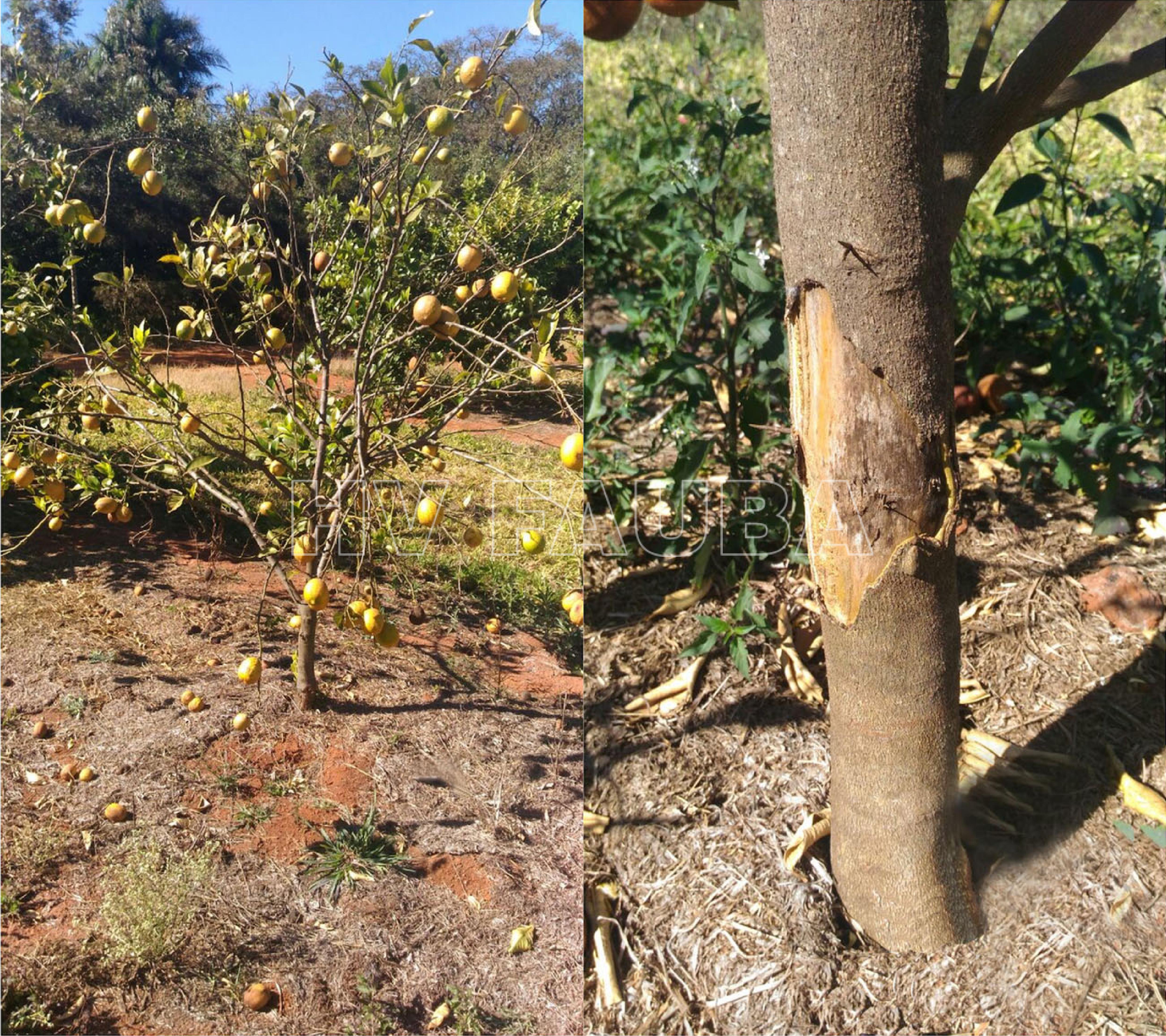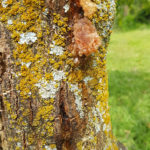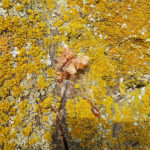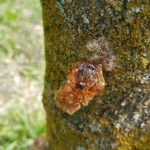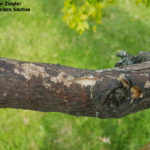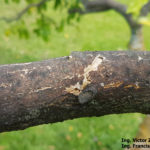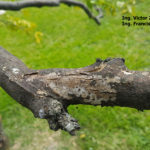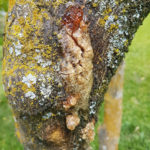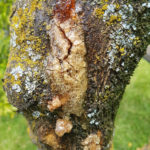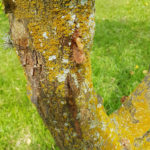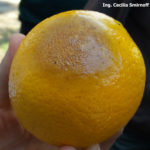.
Condición fitosanitaria: Presente
Grupo de cultivos: Frutales (Cítricos)
Especie hospedante: Limonero (Citrus limon)
Etiología: Pseudohongo. Necrotrófico
Agente causal: Phytophthora citrophthora (R. E. Sm. & E. H. Sm.) Leonian 1906, P. parasitica, Phytophthora spp.
Taxonomía: Eukaryota > Stramenopiles > Oomycetes > Peronosporales > Phytophthora
.
.
Síntomas
La enfermedad destruye las raíces de los pie de injerto susceptibles. El pseudohongo pudre la corteza, la cual se vuelve blanda y se separa de los haces vasculares. Por lo tanto, la absorción de agua y nutrientes se ve severamente comprometida. Los árboles crecen pobremente, las reservas energéticas se consumen y agotan, y la producción declina.
Síntomas generales:
– Declive lento
– Follaje verde claro
– Las hojas se enfrentan como en el estrés hídrico
– Síndrome de hojas pequeñas con severa deficiencia de zinc
– Reducción del dosel: pérdida de la hojas
– Savia que mana del tronco inferior (gomosis)
– Dieback
– Muerte (combinación de variedades muy susceptibles, razas altamente virulentas, acumulación de inóculo, condiciones ambientales conducentes para la enfermedad).
.
- Síntomas de la Gomosis de los cítricos. Izquierda: Amarillamiento de las hojas y la muerte de un limonero. Derecha: Lesión de podredumbre del tallo en un limonero. Autor: Lima et al., 2018.
.
- Síntomas de pudrición de raíz y corona de arbol de granada (Punica granatum) en Irán, similar a una gomosis en cítricos. Autor: Ghaderi y Habibi, 2020.
.
.
Manejo Integrado
* Plantación de variedades / combinaciones con porta injertos resistentes o tolerantes.
* Regular la irrigación (evitar excesos hídricos, y no regar en la misma ubicación que el tronco)
* Uso de fungicidas
* Uso de activadores de las defensas de las plantas, ej. fosfitos, fosetil aluminio, etc.
.
.
- 01 Síntomas de «Gomosis» o Podredumbre de los citrus, producida por Phytophthora spp
- 02 Síntomas de «Gomosis» o Podredumbre de los citrus, producida por Phytophthora spp
- 03 Síntomas de «Gomosis» o Podredumbre de los citrus, producida por Phytophthora spp
- 04 Síntomas de «Gomosis» o Podredumbre de los citrus, producida por Phytophthora spp
- 05 Síntomas de «Gomosis» o Podredumbre de los citrus, producida por Phytophthora spp
- 06 Síntomas de «Gomosis» o Podredumbre de los citrus, producida por Phytophthora spp
- 07 Síntomas de «Gomosis» o Podredumbre de los citrus, producida por Phytophthora spp
- 08 Síntomas de «Gomosis» o Podredumbre de los citrus, producida por Phytophthora spp
- 09 Síntomas de «Gomosis» o Podredumbre de los citrus, producida por Phytophthora spp
- 10 Síntomas de «Gomosis» o Podredumbre de los citrus, producida por Phytophthora spp
- 01 Síntoma en fruto de la «Gomosis» o Podredumbre de los citrus, producida por Phytophthora spp.
.
.
.
Bibliografía
Afek U, Sztejnberg A (1988) Accumulation of scoparone, a phytoalexin associated with resistance of citrus to Phytophthora citrophthora. Phytopathology 78: 1678 -1682.
Avila-Quezada GD, Rai M (2023) Novel nanotechnological approaches for managing Phytophthora diseases of plants. Trends Plant Sci.: S1360-1385(23)00102-4. doi: 10.1016/j.tplants.2023.03.022
Bawage S, Nerkar S, Kumar A, Das A (2013) Morphological and molecular description of Phytophthora insolita isolated from citrus orchard in India. Journal of Mycology. doi: 10.1155/2013/247951
Belisle RJ, Hao W, Riley N, et al. (2022) Root absorption and limited mobility of mandipropamid as compared to oxathiapiprolin and mefenoxam after soil treatment of citrus plants for managing Phytophthora root rot. Plant Dis. doi: 10.1094/PDIS-07-22-1699-RE
Biasi A, Martin FN, Cacciola SO, Magnano di San Lio G, Grünwald NJ, Schena L (2016) Genetic analysis of Phytophthora nicotianae populations from different hosts using microsatellite markers. Phytopathology 106(9): 1006-1014. doi: 10.1094/PHYTO-11-15-0299-R
Blair JE, Coffey MD, Park S-Y, Geiser DM, Kang S (2008) A multi-locus phylogeny for Phytophthora utilizing markers derived from complete pathogen genomes. Fungal Genetics and Biology: 45: 266–277. doi: 10.1016/j.fgb.2007.10.010
Boughalleb-M’hamdi N, Benfradj N, Migliorini D. et al. (2018) Phytophthora nicotianae and P. cryptogea causing gummosis of citrus crops in Tunisia. Trop. plant pathol. 43: 36–48. doi: 10.1007/s40858-017-0180-2
Brasier C, Scanu B, Cooke D, Jung T (2022) Phytophthora: an ancient, historic, biologically and structurally cohesive and evolutionarily successful generic concept in need of preservation. IMA Fungus 13(1): 12. doi: 10.1186/s43008-022-00097-z
Brentu FC, Vicent A (2015) Gummosis of citrus in Ghana caused by Phytophthora citrophthora . Australasian Plant Dis. Notes 10: 34. doi: 10.1007/s13314-015-0184-z
, , , et al. (2020) Towards a best practice methodology for the detection of Phytophthora species in soils. Plant Pathology 00: 1– 11. doi: 10.1111/ppa.13312
Cacciola SO, Magnano di San Lio G (2008) Management of citrus diseases caused by Phytophthora spp. In Ciancio A. and Mukerji K. G. (eds.) Integrated Management of Diseases Caused by Fungi, Phytoplasma and Bacteria. Series: Integrated Management of Plant Pests and Diseases. Springer Science +Business Media B. V., Heidelberg, Germany vol. 3: pp. 61–84.
Català S, Pérez-Sierra A, Abad-Campos P (2015) The Use of Genus-Specific Amplicon Pyrosequencing to Assess Phytophthora Species Diversity Using eDNA from Soil and Water in Northern Spain. PLoS ONE 10(3): e0119311. doi: 10.1371/journal.pone.0119311
De Patrizio A, Cacciola SO, Olsson C, Faedda R, Ramstedt M, Wright S, et al. (2013) Identification of Phytophthora species infecting citrus in Vietnam. J Plant Pathol. ; 95: S4: S41.
Evoli M (2016) Molecular analysis of genetic diversity of Phytophthora citrophthora using nuclear and mitochondrial markers. Ph.D. Thesis.
, Morphological and molecular characterization of Phytophthora species associated with root and crown rot of pomegranate in Iran. Plant Pathology 00: 1– 15. doi: 10.1111/ppa.13320
Gallegly ME, Hong CX (2008) Phytophthora: Identifying Species by Morphology and DNA Fingerprints. APS Press, St Paul, MN. p.158.
Gao RF, Wang JY, Liu KW, et al. (2021) Comparative analysis of Phytophthora genomes data. Data Brief. 39: 107663. doi: 10.1016/j.dib.2021.107663
Gou X, Zhong C, Zhang P, et al. (2022) miR398b and AtC2GnT form a negative feedback loop to regulate Arabidopsis thaliana resistance against Phytophthora parasitica. Plant J. doi: 10.1111/tpj.15792
Gray MA, Nguyen KA, Hao W, et al. (2020) Mobility of Oxathiapiprolin and Mefenoxam in Citrus Seedlings After Root Application and Implications for Managing Phytophthora Root Rot. Plant Disease 104(12): 3159-3165. doi: 10.1094/PDIS-02-20-0391-RE
Hao W, Förster H, Adaskaveg JE (2021) Resistance to Potassium Phosphite in Phytophthora Species Causing Citrus Brown Rot and Integrated Practices for Management of Resistant Isolates. Plant Dis. 105(4): 972-977. doi: 10.1094/PDIS-06-20-1414-RE
Hunter S, Williams N, McDougal R, et al. (2018) Evidence for rapid adaptive evolution of tolerance to chemical treatments in Phytophthora species and its practical implications. PLoS One 13(12): e0208961. doi: 10.1371/journal.pone.0208961
Jung T, Blaschke H (1996) Phytophthora root rot in declining forest trees. Phyton 36 (3): 95–102.
Jung T, Orlikowski L, Henricot B, Abad-Campos P, Aday AG, Aguín Casal O., et al. (2016) Widespread Phytophthora infestations in European nurseries put forest, semi-natural and horticultural ecosystems at high risk of Phytophthora diseases. Forest Pathology 46: 134–163. doi: 10.1111/efp.12239
Kasteel M, Ketelaar T, Govers F (2023) Fatal attraction: How Phytophthora zoospores find their host. Semin Cell Dev Biol. 148-149: 13-21. doi: 10.1016/j.semcdb.2023.01.014
Kato F, Ando Y, Tanaka A, et al. (2022) Synthesis of aglycones, structure-activity relationships, and mode of action of lycosides as inhibitors of the asexual reproduction of Phytophthora. Biosci Biotechnol Biochem. : zbac179. doi: 10.1093/bbb/zbac179
Kronmiller BA, Feau N, Shen D, et al. (2023) Comparative Genomic Analysis of 31 Phytophthora Genomes Reveals Genome Plasticity and Horizontal Gene Transfer. Mol Plant Microbe Interact. 36(1): 26-46. doi: 10.1094/MPMI-06-22-0133-R
Kroon LP, Brouwer H, de Cock AW, Govers F (2012) The Genus Phytophthora. Phytopathology. 102: 348–364. doi: 10.1094/PHYTO-01-11-0025
Lima RPM, Máximo HJ, Merfa MV, et al. (2018) Genetic tools and strategies for citrus breeding aiming at resistant rootstocks to gummosis disease. Tropical Plant Pathology 43(4): 279–288. doi: 10.1007/s40858-018-0229-x
Lin X, Torres Ascurra YC, Fillianti H, et al. (2023) Recognition of Pep-13/25 MAMPs of Phytophthora localizes to an RLK locus in Solanum microdontum. Front Plant Sci. 13: 1037030. doi: 10.3389/fpls.2022.1037030
Martin FN, Abad GZ, Balci Y, Ivors K (2012) Identification and Detection of Phytophthora: Reviewing Our Progress, Identifying Our Needs. Phytopathology 96(8): 1080-1103. doi: 10.1094/PDIS-12-11-1036-FE
Neupane K, Ghimire B, Baysal-Gurel F (2022) Efficacy and Timing of Application of Fungicides, Biofungicides, Host-Plant Defense Inducers, and Fertilizer to Control Phytophthora Root Rot of Flowering Dogwoods in Simulated Flooding Conditions in Container Production. Plant Disease. doi: 10.1094/PDIS-02-22-0437-RE
Panda A, Sen D, Ghosh A, et al. (2018) EumicrobeDBLite: a lightweight genomic resource and analytic platform for draft oomycete genomes. Molecular Plant Pathology 19: 227–237. doi: 10.1111/mpp.12505
Pane A, Cacciola SO, Scibetta S, Bentivenga G, Magnano di San Lio G (2009) Four Phytophthora species causing foot and root rot of apricot in Italy. Plant Disease 93: 844. doi: 10.1094/PDIS-93-8-0844C
Prigigallo MI, Abdelfattah A, Cacciola SO, Faedda R, Sanzani SM, Cooke DEL, Schena L (2015) Metabarcoding analysis of Phytophthora diversity using genus specific primers and 454 pyrosequencing. Phytopathology 106(3): 305-313. doi: 10.1094/PHYTO-07-15-0167-R
Puglisi I, De Patrizio A, Schena L, Jung T, Evoli M, Pane A, et al. (2017) Two previously unknown Phytophthora species associated with brown rot of Pomelo (Citrus grandis) fruits in Vietnam. PLoS ONE 12(2): e0172085. doi: 10.1371/journal.pone.0172085
Sawake MM, Moharil MP, Ingle YV, et al. (2022) Management of Phytophthora parasitica causing gummosis in citrus using biogenic copper oxide nanoparticles. J Appl Microbiol. doi: 10.1111/jam.15472
Scibetta S, Schena L, Chimento A, et al. (2012) A molecular method to assess Phytophthora diversity in environmental samples. Journal of Microbiological Methods 88: 356–368. doi: 10.1016/j.mimet.2011.12.012
Situ J, Xi P, Lin L, et al. (2022) Signal and regulatory mechanisms involved in spore development of Phytophthora and Peronophythora. Front Microbiol. 13: 984672. doi: 10.3389/fmicb.2022.984672
Srivastava SK, Knight LM, Nakhla MK, Abad ZG (2021) Genome Resources for the Ex-type of Phytophthora citricola, and well-authenticated isolates of P. hibernalis, P. nicotianae and P. syringae. Phytopathology doi: 10.1094/PHYTO-04-21-0167-A
Trinh J, Li T, Franco JY, et al. (2022) Citrus relatives exhibit natural variation in perception and response magnitude to microbial features. bioRxiv 2022.07.15.500235; doi: 10.1101/2022.07.15.500235
Wang R, Zhou R, Meng Y, et al. (2023) Specific detection of Phytophthora parasitica by recombinase polymerase amplification (RPA) assays based on a unique multi-copy genomic sequence. Plant Dis. doi: 10.1094/PDIS-04-23-0722-RE
Xu J, Li Y, Jia J, et al. (2022) Mutations in PpAGO3 Lead to Enhanced Virulence of Phytophthora parasitica by Activation of 25-26 nt sRNA-Associated Effector Genes. Front Microbiol. 13: 856106. doi: 10.3389/fmicb.2022.856106
